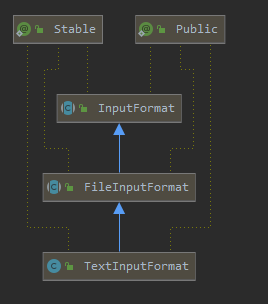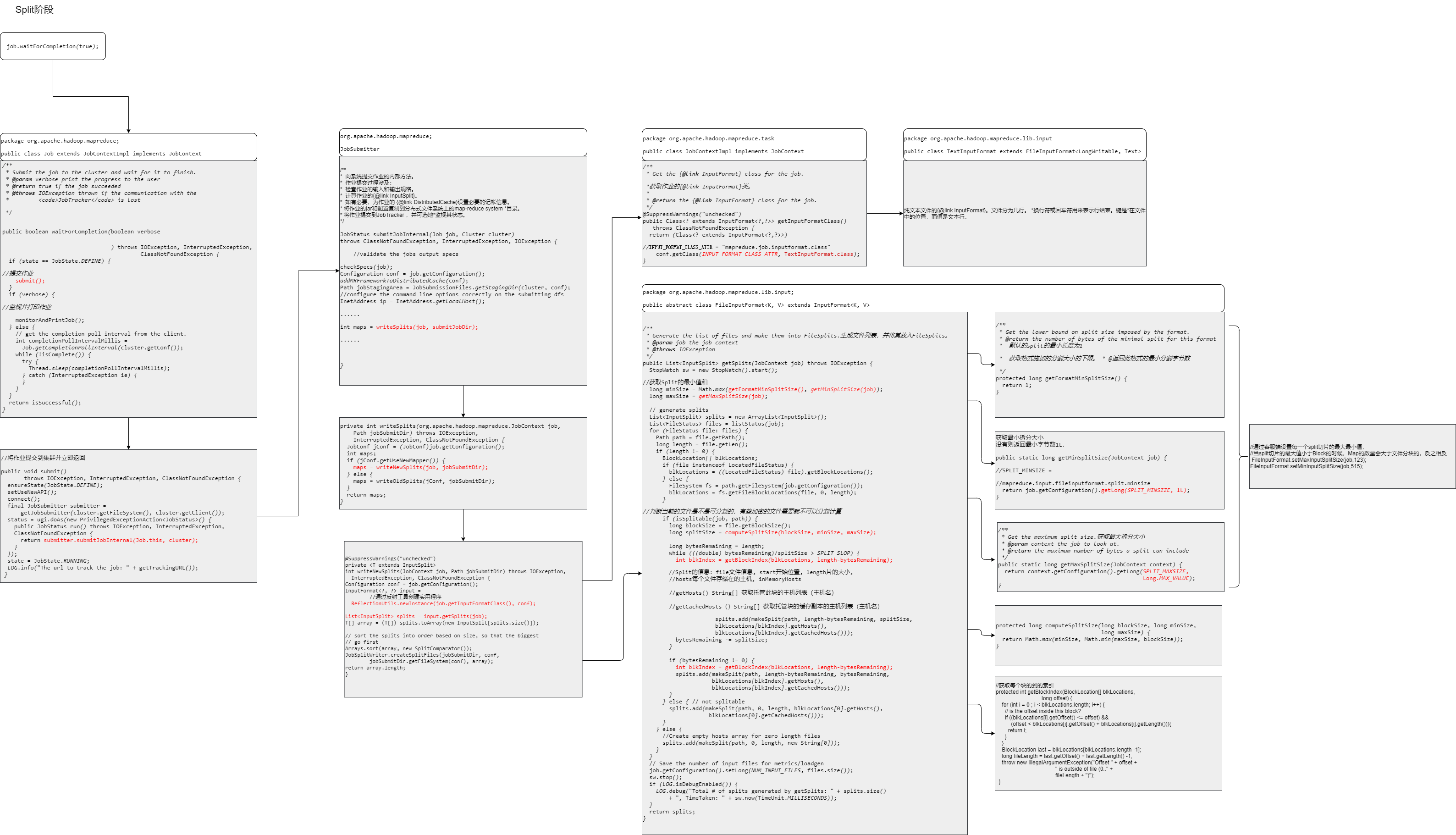MapReduce源码分析
MapReduce源码分析
Job
waitForCompletion方法
public boolean waitForCompletion(boolean verbose
) throws IOException, InterruptedException,
ClassNotFoundException {
if (state == JobState.DEFINE) {
//提交作业
submit();
}
//是否监控
if (verbose) {
//监视并打印作业
monitorAndPrintJob();
} else {
// get the completion poll interval from the client.
int completionPollIntervalMillis =
Job.getCompletionPollInterval(cluster.getConf());
while (!isComplete()) {
try {
Thread.sleep(completionPollIntervalMillis);
} catch (InterruptedException ie) {
}
}
}
return isSuccessful();
}
/**
* Submit the job to the cluster and return immediately.
* @throws IOException
*/
public void submit()
throws IOException, InterruptedException, ClassNotFoundException {
ensureState(JobState.DEFINE);
setUseNewAPI();
connect();
final JobSubmitter submitter =
getJobSubmitter(cluster.getFileSystem(), cluster.getClient());
status = ugi.doAs(new PrivilegedExceptionAction<JobStatus>() {
public JobStatus run() throws IOException, InterruptedException,
ClassNotFoundException {
//提交者 提交内部作业
return submitter.submitJobInternal(Job.this, cluster);
}
});
state = JobState.RUNNING;
LOG.info("The url to track the job: " + getTrackingURL());
}
JobSubmitter 作业提交者
submitJobInternal方法
/**
* Internal method for submitting jobs to the system.
*
* <p>The job submission process involves:
* <ol>
* <li>
* Checking the input and output specifications of the job.
* </li>
* <li>
* Computing the {@link InputSplit}s for the job.
* </li>
* <li>
* Setup the requisite accounting information for the
* {@link DistributedCache} of the job, if necessary.
* </li>
* <li>
* Copying the job's jar and configuration to the map-reduce system
* directory on the distributed file-system.
* </li>
* <li>
* Submitting the job to the <code>JobTracker</code> and optionally
* monitoring it's status.
* </li>
* </ol></p>
* @param job the configuration to submit
* @param cluster the handle to the Cluster
* @throws ClassNotFoundException
* @throws InterruptedException
* @throws IOException
*/
JobStatus submitJobInternal(Job job, Cluster cluster)
throws ClassNotFoundException, InterruptedException, IOException {
//验证作业输出规格
checkSpecs(job);
//获取配置
Configuration conf = job.getConfiguration();
//将MR框架添加到分布式缓存
addMRFrameworkToDistributedCache(conf);
//作业提交文件 获取暂存目录
Path jobStagingArea = JobSubmissionFiles.getStagingDir(cluster, conf);
......
try {
//获取要写入的Splits的切片数量
int maps = writeSplits(job, submitJobDir);
conf.setInt(MRJobConfig.NUM_MAPS, maps);
LOG.info("number of splits:" + maps);
// write "queue admins of the queue to which job is being submitted"
// to job file.
String queue = conf.get(MRJobConfig.QUEUE_NAME,
JobConf.DEFAULT_QUEUE_NAME);
AccessControlList acl = submitClient.getQueueAdmins(queue);
conf.set(toFullPropertyName(queue,
QueueACL.ADMINISTER_JOBS.getAclName()), acl.getAclString());
// removing jobtoken referrals before copying the jobconf to HDFS
// as the tasks don't need this setting, actually they may break
// because of it if present as the referral will point to a
// different job.
TokenCache.cleanUpTokenReferral(conf);
if (conf.getBoolean(
MRJobConfig.JOB_TOKEN_TRACKING_IDS_ENABLED,
MRJobConfig.DEFAULT_JOB_TOKEN_TRACKING_IDS_ENABLED)) {
// Add HDFS tracking ids
ArrayList<String> trackingIds = new ArrayList<String>();
for (Token<? extends TokenIdentifier> t :
job.getCredentials().getAllTokens()) {
trackingIds.add(t.decodeIdentifier().getTrackingId());
}
conf.setStrings(MRJobConfig.JOB_TOKEN_TRACKING_IDS,
trackingIds.toArray(new String[trackingIds.size()]));
}
// Set reservation info if it exists
ReservationId reservationId = job.getReservationId();
if (reservationId != null) {
conf.set(MRJobConfig.RESERVATION_ID, reservationId.toString());
}
// Write job file to submit dir
writeConf(conf, submitJobFile);
//
// Now, actually submit the job (using the submit name)
//
printTokens(jobId, job.getCredentials());
status = submitClient.submitJob(
jobId, submitJobDir.toString(), job.getCredentials());
if (status != null) {
return status;
} else {
throw new IOException("Could not launch job");
}
} finally {
if (status == null) {
LOG.info("Cleaning up the staging area " + submitJobDir);
if (jtFs != null && submitJobDir != null)
jtFs.delete(submitJobDir, true);
}
}
}
- 检查作业的输入和输出规格。
- 计算作业的输入切片InputSplit
- 如有必要,为作业的*{@link DistributedCache}设置必要的记帐信息。
- 将作业的jar和配置复制到分布式文件系统上的map-reduce system 目录。
- 将作业提交到 JobTracker ,并可选地*监视其状态。
writeSplits 计算Split的数量
private int writeSplits(org.apache.hadoop.mapreduce.JobContext job,
Path jobSubmitDir) throws IOException,
InterruptedException, ClassNotFoundException {
JobConf jConf = (JobConf)job.getConfiguration();
int maps;
if (jConf.getUseNewMapper()) {
//我是使用的是新的计算方式,老的计算方式应该是给上个1.X版本的把
maps = writeNewSplits(job, jobSubmitDir);
} else {
maps = writeOldSplits(jConf, jobSubmitDir);
}
return maps;
}
writeNewSplits 写入新的Split
@SuppressWarnings("unchecked")
private <T extends InputSplit>
int writeNewSplits(JobContext job, Path jobSubmitDir) throws IOException,
InterruptedException, ClassNotFoundException {
Configuration conf = job.getConfiguration();
InputFormat<?, ?> input =
//通过反射工具创建实用程序
ReflectionUtils.newInstance(job.getInputFormatClass(), conf);
List<InputSplit> splits = input.getSplits(job);
T[] array = (T[]) splits.toArray(new InputSplit[splits.size()]);
// sort the splits into order based on size, so that the biggest
// go first
Arrays.sort(array, new SplitComparator());
JobSplitWriter.createSplitFiles(jobSubmitDir, conf,
jobSubmitDir.getFileSystem(conf), array);
return array.length;
}
job.getInputFormatClass()方法我们看的是JobContextImpl实现类的方法获取作业的{@link InputFormat}类
/**
* Get the {@link InputFormat} class for the job.
*
* @return the {@link InputFormat} class for the job.
*/
@SuppressWarnings("unchecked")
public Class<? extends InputFormat<?,?>> getInputFormatClass()
throws ClassNotFoundException {
return (Class<? extends InputFormat<?,?>>)
//获取用户的mapreduce.job.inputformat.class类,存在就获取用户输入的,如果没有就用默认的TextInputFormat
conf.getClass(INPUT_FORMAT_CLASS_ATTR, TextInputFormat.class);
}
默认的TextInputFormat文字输入格式
用于纯文本文件的{@link InputFormat}。文件分为几行。 换行符或回车符用来表示行结束。键是在文件中的位置,而值是文本行。

通过输入格式化类InputFormat得到Split的个数
/**
* Logically split the set of input files for the job.
*
* <p>Each {@link InputSplit} is then assigned to an individual {@link Mapper}
* for processing.</p>
*
* <p><i>Note</i>: The split is a <i>logical</i> split of the inputs and the
* input files are not physically split into chunks. For e.g. a split could
* be <i><input-file-path, start, offset></i> tuple. The InputFormat
* also creates the {@link RecordReader} to read the {@link InputSplit}.
*
* @param context job configuration.
* @return an array of {@link InputSplit}s for the job.
*/
逻辑上拆分作业的输入文件集。 然后将每个{@link InputSplit}分配给一个单独的{@link Mapper} 进行处理。 注意 :拆分为 逻辑 分割输入和 输入文件实际上并不分割成块。例如分割可以 为 输入文件路径,开始,偏移 元组。 InputFormat *还创建{@link RecordReader}来读取{@link InputSplit}。
分析 .getSplits(job)的实现类FileInputFormat的实现
/**
* Generate the list of files and make them into FileSplits.
* 生成文件列表,并将其放入FileSplits。
* @param job the job context
* @throws IOException
*/
public List<InputSplit> getSplits(JobContext job) throws IOException {
StopWatch sw = new StopWatch().start();
//getFormatMinSplitSize返回的是1,获取格式施加的分割大小的下限 返回此格式的最小分割字节数1
//getMinSplitSize(job)
//单曲可以分析为,用户输入的split的配置和默认的split的切片
long minSize = Math.max(getFormatMinSplitSize(), getMinSplitSize(job));
//如果设置了,就会取出用户的,否则使用默认的
long maxSize = getMaxSplitSize(job);
// generate splits
List<InputSplit> splits = new ArrayList<InputSplit>();
//获取输入的输入文件,也就是Map输入的path获取,因为Map支持多个输入源
List<FileStatus> files = listStatus(job);
//循环的处理每个文件处理成Map的输入切片输入Map中
for (FileStatus file: files) {
Path path = file.getPath();
long length = file.getLen();
if (length != 0) {
BlockLocation[] blkLocations;
if (file instanceof LocatedFileStatus) {
blkLocations = ((LocatedFileStatus) file).getBlockLocations();
} else {
FileSystem fs = path.getFileSystem(job.getConfiguration());
blkLocations = fs.getFileBlockLocations(file, 0, length);
}
//判断文件是不是支持切片的,有些通过压缩算法的文件是不支持切块的
if (isSplitable(job, path)) {
long blockSize = file.getBlockSize();
//获取块文件的大小
long splitSize = computeSplitSize(blockSize, minSize, maxSize);
long bytesRemaining = length;
while (((double) bytesRemaining)/splitSize > SPLIT_SLOP) {
int blkIndex = getBlockIndex(blkLocations, length-bytesRemaining);
//Split的信息:file文件信息, start开始位置, length片的大小, hosts每个文件存储在的主机, inMemoryHosts
//getHosts() String[] 获取托管此块的主机列表(主机名)
//getCachedHosts()String[] 获取托管块的缓存副本的主机列表(主机名)
splits.add(makeSplit(path, length-bytesRemaining, splitSize,
blkLocations[blkIndex].getHosts(),
blkLocations[blkIndex].getCachedHosts()));
bytesRemaining -= splitSize;
}
if (bytesRemaining != 0) {
int blkIndex = getBlockIndex(blkLocations, length-bytesRemaining);
splits.add(makeSplit(path, length-bytesRemaining, bytesRemaining,
blkLocations[blkIndex].getHosts(),
blkLocations[blkIndex].getCachedHosts()));
}
} else { // not splitable
splits.add(makeSplit(path, 0, length, blkLocations[0].getHosts(),
blkLocations[0].getCachedHosts()));
}
} else {
//Create empty hosts array for zero length files
splits.add(makeSplit(path, 0, length, new String[0]));
}
}
// Save the number of input files for metrics/loadgen
job.getConfiguration().setLong(NUM_INPUT_FILES, files.size());
sw.stop();
if (LOG.isDebugEnabled()) {
LOG.debug("Total # of splits generated by getSplits: " + splits.size()
+ ", TimeTaken: " + sw.now(TimeUnit.MILLISECONDS));
}
return splits;
}
/**
* Get the minimum split size
* 返回系统配置的split的配置
* @param job the job
* @return the minimum number of bytes that can be in a split
*/
public static long getMinSplitSize(JobContext job) {
// SPLIT_MINSIZE mapreduce.input.fileinputformat.split.minsize的配置文件参数
return job.getConfiguration().getLong(SPLIT_MINSIZE, 1L);
}
/**
* Get the maximum split size.
* @param context the job to look at.
* @return the maximum number of bytes a split can include
*/
public static long getMaxSplitSize(JobContext context) {
return context.getConfiguration().getLong(SPLIT_MAXSIZE,
Long.MAX_VALUE);
}
protected long computeSplitSize(long blockSize, long minSize,
long maxSize) {
return Math.max(minSize, Math.min(maxSize, blockSize));
}
//通过客服端设置每一个split切片的最大最小值,
//当split切片的最大值小于Block的时候,Map的数量会大于文件分块的,反之相反
FileInputFormat.setMaxInputSplitSize(job,123);
FileInputFormat.setMinInputSplitSize(job,515);
//获取每个块的到的索引
protected int getBlockIndex(BlockLocation[] blkLocations,
long offset) {
for (int i = 0 ; i < blkLocations.length; i++) {
// is the offset inside this block?
if ((blkLocations[i].getOffset() <= offset) &&
(offset < blkLocations[i].getOffset() + blkLocations[i].getLength())){
return i;
}
}
BlockLocation last = blkLocations[blkLocations.length -1];
long fileLength = last.getOffset() + last.getLength() -1;
throw new IllegalArgumentException("Offset " + offset +
" is outside of file (0.." +
fileLength + ")");
}

直接现在看看
Map Task

MapTask类的run方法
/** A Map task. */
@InterfaceAudience.LimitedPrivate({"MapReduce"})
@InterfaceStability.Unstable
public class MapTask extends Task {
@Override
public void run(final JobConf job, final TaskUmbilicalProtocol umbilical)
throws IOException, ClassNotFoundException, InterruptedException {
this.umbilical = umbilical;
if (isMapTask()) {
// 判断Reduce的数量是不是等于0,
if (conf.getNumReduceTasks() == 0) {
mapPhase = getProgress().addPhase("map", 1.0f);
} else {
// 如果存在Reduce存在一个或者多个,执行Map,还要执行排序
mapPhase = getProgress().addPhase("map", 0.667f);
sortPhase = getProgress().addPhase("sort", 0.333f);
}
}
//开始计算调度算法
TaskReporter reporter = startReporter(umbilical);
boolean useNewApi = job.getUseNewMapper();
initialize(job, getJobID(), reporter, useNewApi);
// check if it is a cleanupJobTask
if (jobCleanup) {
runJobCleanupTask(umbilical, reporter);
return;
}
if (jobSetup) {
runJobSetupTask(umbilical, reporter);
return;
}
if (taskCleanup) {
runTaskCleanupTask(umbilical, reporter);
return;
}
//是不是使用新的API
if (useNewApi) {
//我们使用的是新的API
runNewMapper(job, splitMetaInfo, umbilical, reporter);
} else {
runOldMapper(job, splitMetaInfo, umbilical, reporter);
}
done(umbilical, reporter);
}
public Progress getSortPhase() {
return sortPhase;
}
}
job.setNumReduceTasks(1111);
可以在客服端设置Reduce的数量
切片是计算出来的,我们可以通过设置Split的大小来控制Map,Reduce是设置的。默认的Reduce的数量为1个。
public int getNumReduceTasks() { return getInt(JobContext.NUM_REDUCES, 1); }
@SuppressWarnings("unchecked")
private <INKEY,INVALUE,OUTKEY,OUTVALUE>
void runNewMapper(final JobConf job,
final TaskSplitIndex splitIndex,
final TaskUmbilicalProtocol umbilical,
TaskReporter reporter
) throws IOException, ClassNotFoundException,
InterruptedException {
// 创建任务上下文,以便我们获取课程
org.apache.hadoop.mapreduce.TaskAttemptContext taskContext =
new org.apache.hadoop.mapreduce.task.TaskAttemptContextImpl(job,
getTaskID(),
reporter);
// 创建map
org.apache.hadoop.mapreduce.Mapper<INKEY,INVALUE,OUTKEY,OUTVALUE> mapper =
(org.apache.hadoop.mapreduce.Mapper<INKEY,INVALUE,OUTKEY,OUTVALUE>)
ReflectionUtils.newInstance(taskContext.getMapperClass(), job);
// 创建输入格式化
org.apache.hadoop.mapreduce.InputFormat<INKEY,INVALUE> inputFormat =
(org.apache.hadoop.mapreduce.InputFormat<INKEY,INVALUE>)
ReflectionUtils.newInstance(taskContext.getInputFormatClass(), job);
// 重新创建切片对象,也就是在客户端得到的Splits是个序列化的对象
org.apache.hadoop.mapreduce.InputSplit split = null;
split = getSplitDetails(new Path(splitIndex.getSplitLocation()),
splitIndex.getStartOffset());
LOG.info("Processing split: " + split);
//新的跟踪记录阅读器对象
org.apache.hadoop.mapreduce.RecordReader<INKEY,INVALUE> input =
new NewTrackingRecordReader<INKEY,INVALUE>
(split, inputFormat, reporter, taskContext);
job.setBoolean(JobContext.SKIP_RECORDS, isSkipping());
org.apache.hadoop.mapreduce.RecordWriter output = null;
// get an output object
if (job.getNumReduceTasks() == 0) {
output =
new NewDirectOutputCollector(taskContext, job, umbilical, reporter);
} else {
output = new NewOutputCollector(taskContext, job, umbilical, reporter);
}
//map自己的上下文的创建
org.apache.hadoop.mapreduce.MapContext<INKEY, INVALUE, OUTKEY, OUTVALUE>
mapContext =
new MapContextImpl<INKEY, INVALUE, OUTKEY, OUTVALUE>(job, getTaskID(),
input, output,
committer,
reporter, split);
org.apache.hadoop.mapreduce.Mapper<INKEY,INVALUE,OUTKEY,OUTVALUE>.Context
mapperContext =
new WrappedMapper<INKEY, INVALUE, OUTKEY, OUTVALUE>().getMapContext(
mapContext);
try {
//输入初始化
input.initialize(split, mapperContext);
//调用Map中run方法
mapper.run(mapperContext);
//map阶段执行完毕
mapPhase.complete();
setPhase(TaskStatus.Phase.SORT);
statusUpdate(umbilical);
//关闭map的输入流
input.close();
input = null;
//关闭map阶段的输出流,关闭之前会把最后的数据刷新输出完毕
output.close(mapperContext);
output = null;
} finally {
closeQuietly(input);
closeQuietly(output, mapperContext);
}
}
创建map的时候初始化的过程

我们来看
package org.apache.hadoop.mapreduce.task;
public class JobContextImpl implements JobContext {
/**
* Get the {@link Mapper} class for the job.
*
* @return the {@link Mapper} class for the job.
*/
@SuppressWarnings("unchecked")
public Class<? extends Mapper<?,?,?,?>> getMapperClass()
throws ClassNotFoundException {
return (Class<? extends Mapper<?,?,?,?>>)
// MAP_CLASS_ATTR = "mapreduce.job.map.class";
conf.getClass(MAP_CLASS_ATTR, Mapper.class);
}
}
输入格式化
/**
* Get the {@link InputFormat} class for the job.
*
* @return the {@link InputFormat} class for the job.
*/
@SuppressWarnings("unchecked")
public Class<? extends InputFormat<?,?>> getInputFormatClass()
throws ClassNotFoundException {
return (Class<? extends InputFormat<?,?>>)
//INPUT_FORMAT_CLASS_ATTR = "mapreduce.job.inputformat.class";
conf.getClass(INPUT_FORMAT_CLASS_ATTR, TextInputFormat.class);
}
新的跟踪记录阅读器对象创建的过程
NewTrackingRecordReader(org.apache.hadoop.mapreduce.InputSplit split,
org.apache.hadoop.mapreduce.InputFormat<K, V> inputFormat,
TaskReporter reporter,
org.apache.hadoop.mapreduce.TaskAttemptContext taskContext)
throws InterruptedException, IOException {
this.reporter = reporter;
this.inputRecordCounter = reporter
.getCounter(TaskCounter.MAP_INPUT_RECORDS);
this.fileInputByteCounter = reporter
.getCounter(FileInputFormatCounter.BYTES_READ);
List <Statistics> matchedStats = null;
if (split instanceof org.apache.hadoop.mapreduce.lib.input.FileSplit) {
matchedStats = getFsStatistics(((org.apache.hadoop.mapreduce.lib.input.FileSplit) split)
.getPath(), taskContext.getConfiguration());
}
fsStats = matchedStats;
long bytesInPrev = getInputBytes(fsStats);
//创建一个创建记录读取器
this.real = inputFormat.createRecordReader(split, taskContext);
long bytesInCurr = getInputBytes(fsStats);
fileInputByteCounter.increment(bytesInCurr - bytesInPrev);
}
inputFormat.createRecordReader(split, taskContext);
调用的是NewTrackingRecordReader的initialize()的方阿飞
package org.apache.hadoop.mapreduce.lib.input;
public class TextInputFormat extends FileInputFormat<LongWritable, Text> {
@Override
public RecordReader<LongWritable, Text>
createRecordReader(InputSplit split,
TaskAttemptContext context) {
String delimiter = context.getConfiguration().get(
"textinputformat.record.delimiter");
byte[] recordDelimiterBytes = null;
if (null != delimiter)
recordDelimiterBytes = delimiter.getBytes(Charsets.UTF_8);
//返回一个以行为单位的记录读取器
return new LineRecordReader(recordDelimiterBytes);
}
@Override
protected boolean isSplitable(JobContext context, Path file) {
final CompressionCodec codec =
new CompressionCodecFactory(context.getConfiguration()).getCodec(file);
if (null == codec) {
return true;
}
return codec instanceof SplittableCompressionCodec;
}
}
LineRecordReader(recordDelimiterBytes)得到的是对于的
=========
未完待续:
记得加油学习哦^_^

